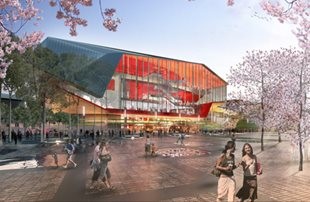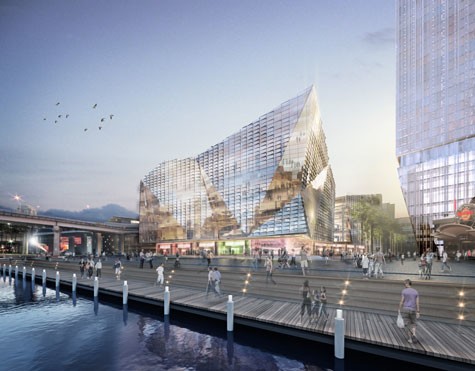Richard Breslin, senior principal at Populous, has worked on the Wembley Stadium in the UK and ANZ Stadium in Australia.
Recently, joint venture partners, Populous and HASSELL, won the architectural contract for the design of Sydney’s new integrated convention, exhibition and entertainment precinct at Darling Harbour, due for completion in 2016.
Architecture & Design spoke to Breslin about the Darling Harbour project, working on a site in Italy which had been bombed in World War II and why he enjoys working on public buildings.
What is your design solution for the Darling Harbour project?
The HASSELL+Populous team are design consultants to Darling Harbour Live, the Lend Lease-led consortium selected by the New South Wales government to redevelop the $1 billion new international convention, exhibition and entertainment precinct at Darling Harbour. It is rare to have the opportunity to design 100,000 sqm of building to create something entirely new within the inner city fabric of a major world city.

 Darling Harbour concept images courtesy Hassell
Darling Harbour concept images courtesy Hassell
We have observed that the needs of the meeting industry are changing, and while Convention and Exhibition centres do retain a unique focus, it is now combined with the desire to contribute to the local neighbourhood. The Sydney precinct will be the same – a development for a modern urban community, a catalyst for business and urban development and a major international destination.

The Convention Centre will be deliberately clad in materials which reflect its harbour outlook and will be capable of holding three separate concurrent events. The Convention Centre will be complemented by the rest of the precinct, which looks out onto parkland. At this point, the building’s boundaries are set back, designed so the landscape becomes part of the building, with circulation and meeting spaces open to the park. There will be total exhibition capacity of 40,000 sqm, an external events deck of 5,000 sqm and a plenary hall which can be converted to an entertainment theatre with a seating capacity of 8,000.
Our design has focused on developing the public realm within the precinct by both improving its usability and increasing the area of public space. This has been a key factor in defining the ground plane and massing, which eventually developed into the architectural response.
What are the challenges of the project?
The greatest challenge has been to fit the program requirements of such significant public venues in such an important urban precinct in the centre of Sydney, within the competitive environment of a PPP. To put this into context, the existing exhibition halls are 25,000 sqm and this occupies the entire space between the Western Distributor and Pier Street. We’ve redesigned the space to achieve 35,000 sqm of exhibition hall, a 5,000 sqm open air event deck, plus an 8,000 seat theatre. We have increased the public space and also provided two new east- west pedestrian links within the same space.
Do you expect any controversy around the project, considering it is such a public space in Sydney?
There is inevitably controversy around such large pieces of public infrastructure - that makes it interesting, and it’s important people have a chance to express their opinions about the development of their city. The design team will be working for Darling Habour Live to make sure we provide a truly world class destination for Sydney and visitors alike.
Why do you enjoy working on public and sporting buildings?
I have a great passion for these building types. The scale of projects like Wembley Stadium, the London 2012 Olympics and the Sydney Convention Exhibition and Entertainment precinct are so large and complex, it can be overwhelming. But you are always working with the best in the industry to make them a reality and being involved on projects which evoke so much energy from so many people is incredibly rewarding. Then, when they are finally built, I like watching people experience and enjoy these buildings.
What has been the most unusual project you have worked on and what was your solution?
I worked on the Palasport Speed Skating Arena in Turin in Italy for the 2006 Winter Olympic Games and the site was particularly interesting. It was adjacent to the Fiat factory in Turin which had been heavily bombed during WW2. As a result we spent a lot of time working with the Italian army identifying areas of greatest risk and mitigating those risks by either not building in a particular place or having the army go in and try and locate unexploded bombs.
If you weren't an architect, what would you be doing?
I did consider changing direction only a couple of years after registering. I’d always been interested in business and was looking to do a Masters in Finance at Sydney University. The course did not start for a few months so I got some contract work on Stadium Australia doing the blockwork package. That was it – I’m yet to go back to Sydney Uni.

